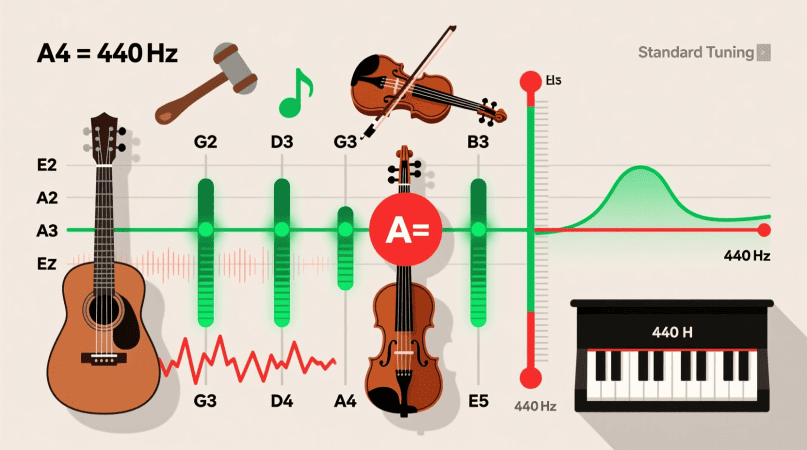
Whether you’re a guitarist, violinist, or pianist, staying in tune is essential. A pitch detector makes the process simple, accurate, and quick — even for beginners.
This guide gives you fast-start tuning steps for each instrument using the free Pitch Detector.
Why Use a Pitch Detector for Instruments?
Traditional tuners work fine, but a pitch detector offers:
- Real-time accuracy with ±cents feedback
- Cross-platform use — desktop, tablet, or phone
- No installation — works instantly in your browser
Guitar Tuning Quick Start
- Open the Pitch Detector: Pitch Detector
- Pluck one string at a time: Start with the low E string.
- Read the Note & ±Cents: The screen shows the note name and how close you are.
- Adjust tuning pegs: Aim for 0–5¢ deviation for best intonation.
- Repeat for all six strings:
- E2 → A2 → D3 → G3 → B3 → E4
Tip: For alternate tunings, refer to a tuning chart and match the note shown on the detector.
Violin Tuning Quick Start
- Use a quiet room to reduce pitch flicker.
- Open the Pitch Detector: Pitch Detector
- Play open strings one at a time:
- G3 → D4 → A4 → E5
- Adjust pegs/fine tuners until the ±cents meter reaches near 0¢.
- Check A4=440 Hz calibration or use 442 Hz if your orchestra requires it.
See our Audio-File Pitch Detector if you want to analyze a violin recording instead.
Piano Tuning Quick Start (Basic Checks)
Piano tuning is usually professional work, but you can:
- Open the Pitch Detector: Pitch Detector
- Play middle A (A4): Confirm it matches 440 Hz (or 442 Hz).
- Spot-check octaves: A3, A5, A6 for drift.
- Call a technician if several keys are out — pianos need full calibration.
For learning or digital pianos, the detector helps confirm octave tuning accuracy quickly.
Common Issues & Fixes
| Issue | Cause | Fix |
|---|---|---|
| Flickering readings | Noise, mic distance | Quiet room, 20–30 cm from mic |
| Wrong octave shown | Harmonic confusion | Play single notes, no chords |
| Sharp/flat readings | Peg slippage, stretch | Tune slowly, re-check after 5 mins |
For troubleshooting flicker, read: Pitch Flicker: 9 Causes & Fixes
FAQs
1. Can I tune electric and acoustic guitars?
Yes. The Pitch Detector works with both; electric guitars may need clean tone signals.
2. Is the violin E string too high for detectors?
No, but use a quiet room and steady notes for better stability.
3. Can I analyze recorded notes for tuning?
Yes, with the Audio-File Pitch Detector.
4. Does A4=442 matter for orchestras?
Yes, many orchestras prefer 442 Hz; switch calibration in the detector settings.
Final Thoughts
For guitar, violin, and basic piano checks, the free Pitch Detector gives instant, accurate tuning feedback with no app installs.
- Guitarists: Tune string by string.
- Violinists: Use quiet rooms & steady notes.
- Pianists: Spot-check A4 and octaves easily.
It’s fast, private, and works on any device.
Pitch Detector is a project by Ornella, blending audio engineering and web technology to deliver precise, real-time pitch detection through your browser. Designed for musicians, producers, and learners who want fast, accurate tuning without installing any software.
